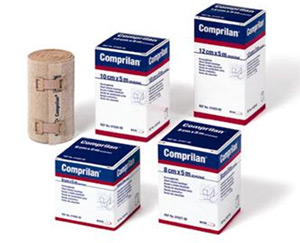Oedema
Venous leg ulcers occur when there is a sustained increase in venous pressure as a result of chronic venous insufficiency and /or impairment of the calf muscle pump. Changes in the venous supply leads to elevated venous pressure, venous stasis, and the development of oedema to the feet and ankles. As a result the skin over the ankles is often thinner, discoloured and may develop venous ulcers.
If the walls of the veins have been destroyed by varicose veins or thrombosis they will expand so that the venous valves cannot close up properly. The blood will then flow back to the superficial veins, which will be overflowing. This results in blood stagnating in the legs and the increased pressure in the superficial veins just under the skin causing oedema.
Compression therapy
The aim of compression therapy is to counteract oedema, prevent capillary leakage into surrounding tissue and promote normal flow of venous blood up the leg. Additionally the compression should also amplify muscle vein pump function and increase the flow in the veins by reducing the diameter of the vein.
Dressings and compression therapy should only be applied by healthcare professionals trained in leg ulcer management and in line with local guidelines. A Doppler assessment should be undertaken prior to commencing compression therapy and should not be used in patients with an ankle brachial index of 0.8 or less. Compression therapy should not be applied to patients if there is active phlebitis, deep vein thrombosis, cellulitis, or to patients who have conditions that are contraindicated e.g. diabetic foot ischaemia, neuropathy or cardiac failure.
Prior to applying the compression bandage the practitioner should measure the person’s ankle circumference and apply below-knee, graduated multi-layer high compression bandaging and replace weekly: for people who are immobile, long-stretch bandaging (2, 3 or 4 layer systems) is more suitable.
For people who are mobile, short stretch bandaging is more practical. Bandage types are classified on the degree of sub-bandage pressure they exert on the limb. Constant tension is needed when applying the bandaging to maintain a sub bandage pressure gradient. The highest pressure is at the ankle and progressively reduces to the knee and thigh.




